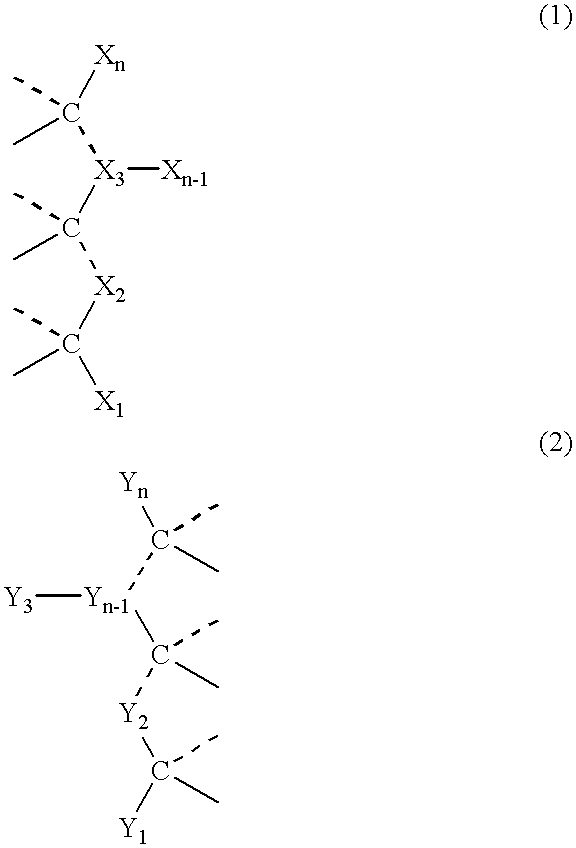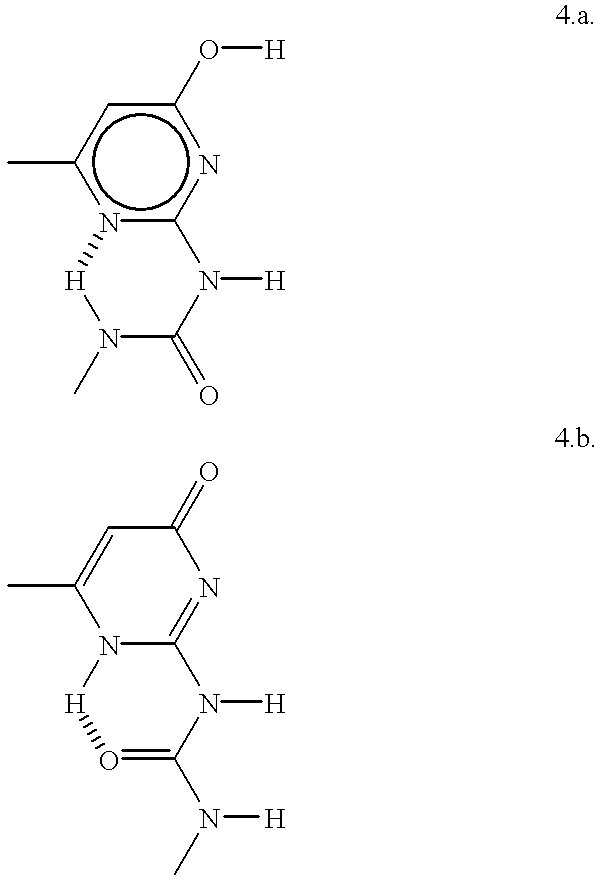Supramolecular polymer
- Summary
- Abstract
- Description
- Claims
- Application Information
AI Technical Summary
Benefits of technology
Problems solved by technology
Method used
Image
Examples
example i
2-butylureido-6-methyl-4-pyrimidone
##STR7##
6-methyl-isocytosine (commercially available) was weighed into a flask (1.24 grams, 0.018 mol). The flask was fitted with a reflux condenser with a nitrogen inlet tube and was brought under a nitrogen atmosphere. 50 ml of dry pyridine was added, followed by butyl isocyanate (2 ml, 0.018 mol). The suspension was heated to reflux temperature, during which a clear solution was slowly obtained (after approx. 1 hour). After 2 hours' boiling while refluxing, the solvent was evaporated, after cooling. The white residue was crystallised from 1 / 1 v / v ethanol / chloroform. Yield 1.63 grams, 66%.
.sup.1 H-NMR (CDCl.sub.3): .delta. (ppm): 13.15 (s, 1H), 11.85 (s, 1H), 10.16 (S, 1H), 5.81 (s, 1H), 3.24 (q, 2H), 3.22 (s, 3H), 1.58 (m, 2H), 1.37 (m, 2H), 0.92 (t, 3H). .sup.13 C-NMR (CDCl.sub.3): .delta. (ppm): 173.0, 156.5, 154.7, 148.1, 106.6, 39.7, 31.5, 20.1, 18.9, 13.7, IR (KBr) (keto form): .upsilon. (cm.sup.-1): 3215, 2954, 2868, 1705, 1666, 1584.
example ii
Ethyl 3-oxo-hexadecanoate
##STR8##
Sodium hydride (60%, 4.42 g, 0.11 mol) was weighed into a dry 3-neck flask (1000 cc). The flask was brought under a nitrogen atmosphere and placed in an ice-salt bath, after which dry THF (250 ml) was added at 0.degree. C. Ethyl acetoacetate (13.02 g, 0.102 mol) was added drop by drop via a dry syringe, at a temperature of between 0 and 5.degree. C. A strongly exothermic reaction took place with gas formation. After 30 minutes' stirring at 0.degree. C., n-butyl lithium (1.6 M, 66 ml, 0.104 mol) was added drop by drop, after which the stirring was continued for 15 min. at 0.degree. C. Dodecyl bromide (127.4 g, 0.110 mol) in dry THF (20 ml) was added via a dry syringe at 0.degree. C. The solution was stirred for 45 min, during which the temperature rose to room temperature and a suspension formed. To this suspension were added concentrated hydrochloric acid (20 ml) in water (600 ml), followed by ether (1000 ml). After extraction, the water layer was on...
example iii
2-phenylureido-6-tridecyl-4-pyrimidone
##STR11##
6-tridecylisocytosine (0.28 g, 0.001 mol) was weighed into a dry 2-neck flask (25 ml). The flask was brought under a nitrogen atmosphere, after which dry pyridine (5 ml) and phenylisocyanate (0.21 ml, 0.0018 mol) were added. After 4 hours' refluxing the mixture was cooled to room temperature and diluted with acetone. The precipitated white powder was filtered.
Recrystallisation from acetic acid resulted in pure 2-phenylureido-6-tridecyl-4-pyrimidone as a microcrystalline powder (0.14 g, 0.00034 mol, 34%).
.sup.1 H-NMR (CDCl.sub.3): .delta. (ppm): 12.99 (s, 1H), 12.21 (s, 1H), 12.19 (s, 1H), 7.70 (d, 2H), 7.34 (t, 2H), 7.09 (t, 1H), 5.83 (s, 1H), 2.31 (t, 2H), 1.53 (m, 2H), 1.26 (m, 20H, 0.90 (t, 3H). .sup.13 C-NMR (CDCl.sub.3): .delta. (ppm): 173.0, 154.6, 152.8, 138.2, 128.9, 123.9, 120.6, 106.0, 32.5, 31.9, 29.6, 29.6, 29.4, 29.4 (overlapping peaks), 29.2, 28.8, 26.6, 22.7, 14.1. IR (KBr) (keto form): .upsilon. (cm.sup.-1): 3133, 3022, ...
PUM
| Property | Measurement | Unit |
|---|---|---|
| Digital information | aaaaa | aaaaa |
| Time | aaaaa | aaaaa |
| Time | aaaaa | aaaaa |
Abstract
Description
Claims
Application Information
 Login to View More
Login to View More - R&D
- Intellectual Property
- Life Sciences
- Materials
- Tech Scout
- Unparalleled Data Quality
- Higher Quality Content
- 60% Fewer Hallucinations
Browse by: Latest US Patents, China's latest patents, Technical Efficacy Thesaurus, Application Domain, Technology Topic, Popular Technical Reports.
© 2025 PatSnap. All rights reserved.Legal|Privacy policy|Modern Slavery Act Transparency Statement|Sitemap|About US| Contact US: help@patsnap.com



